Nestled along the captivating backwaters of Kerala, Alleppey invites travelers to immerse themselves in a tapestry of natural beauty, cultural richness, and unique experiences. As you plan your visit to this enchanting destination in 2024, here’s a curated list of 20+ things to do in Alleppey that promise an unforgettable journey.
Navigating Tranquility: A Houseboat Cruise in Alappuzha
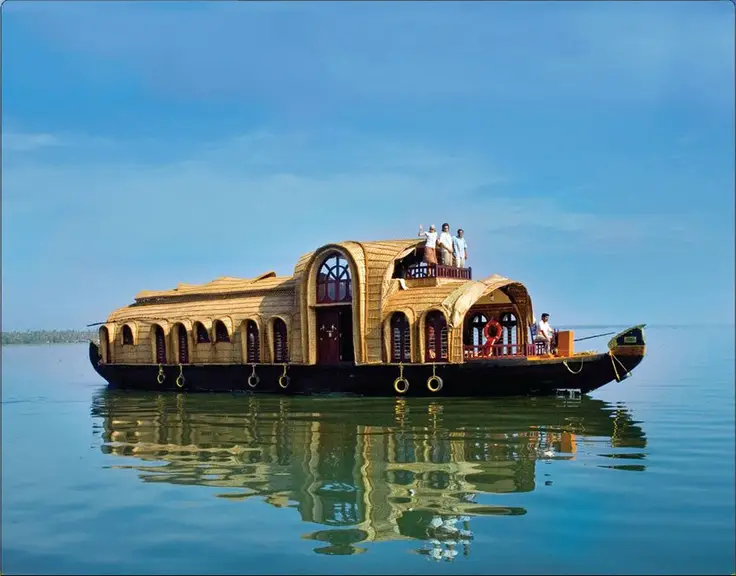
The emerald waters of the Kerala backwaters beckon, promising an enchanting journey through the heart of Alleppey’s natural beauty. A houseboat cruise in Alappuzha is not merely a means of transportation; it’s an immersive experience that unveils the tranquil charm of Kerala’s backwaters. As you plan your visit to this picturesque destination, here’s a guide to the mesmerizing world of houseboat cruises in Alappuzha.
The Floating Retreat:
Embark on a houseboat adventure that transforms your stay into a floating retreat. These traditional Kettuvallams, crafted from bamboo and wood, seamlessly blend age-old charm with modern comforts. Each houseboat is a floating haven, complete with cozy bedrooms, an open deck, and a skilled crew to ensure your journey is nothing short of extraordinary.
Cruising the Backwaters:
The primary allure of an Alappuzha houseboat cruise lies in navigating the intricate network of backwaters. As you glide along the peaceful canals, framed by swaying palms and lush greenery, you’ll witness life unfolding along the water’s edge. Locals tending to their daily chores, vibrant birdlife, and the occasional glimpse of traditional village life paint a serene picture that stays etched in your memory.
Sunset Magic:
One of the most magical moments during your houseboat cruise is the breathtaking sunset over the backwaters. The play of colors across the sky reflects on the still waters, creating a mesmerizing canvas. Enjoy this natural spectacle from the comfort of your houseboat deck, surrounded by the soothing sounds of nature.
Culinary Delights Onboard:
Your houseboat journey is not just a visual feast but a culinary one too. Most houseboats come with skilled chefs who whip up delicious local delicacies on board. Savor the flavors of Kerala with fresh seafood, traditional curries, and aromatic rice dishes, all prepared with the expertise that reflects the culinary richness of the region.
Night on the Water:
As night falls, the houseboat transforms into a cozy haven. The gentle rocking of the boat and the soothing sounds of the water create a tranquil ambiance. Spend the night stargazing from the open deck or retire to your comfortable cabin for a peaceful night’s sleep surrounded by the serenity of the backwaters.
Tailored Experiences:
Houseboat cruises in Alappuzha offer a range of experiences tailored to your preferences. Whether you seek a romantic getaway, a family adventure, or a solo sojourn, there’s a houseboat to suit every traveler. Customize your itinerary to include village visits, bird watching, or simply uninterrupted relaxation.
Booking Your Houseboat Cruise:
Booking a houseboat cruise in Alappuzha is a seamless process, with numerous options available to cater to various budgets. Prices often vary based on the type of houseboat, the duration of the cruise, and the inclusions. It is advisable to book in advance, especially during peak seasons, to ensure availability and secure the best rates.
Alappuzha Beach: A Coastal Oasis Waiting to be Explored

Nestled along the Arabian Sea, Alappuzha Beach stands as a tranquil haven on the southwest coast of India. Beyond its golden sands and azure waters, this coastal gem in Kerala invites travelers to uncover a myriad of experiences. Join us as we embark on a journey to explore the beauty and charm of Alappuzha Beach.
A Serene Escape:
Alappuzha Beach offers a serene escape from the hustle and bustle of everyday life. Whether you’re a sun seeker looking to bask in the warm glow or a nature enthusiast eager to witness the ebb and flow of the tides, the beach provides a perfect setting for relaxation and rejuvenation.
Golden Sands and Azure Waters:
The beach boasts pristine golden sands that stretch as far as the eye can see, caressed by the gentle waves of the Arabian Sea. Take a leisurely stroll along the shore, letting the soft sand massage your feet, or simply find a cozy spot to sit and absorb the beauty of the vast expanse of water.
Sunset Spectacle:
One of the most enchanting experiences at Alappuzha Beach is witnessing the sunset over the Arabian Sea. As the sun dips below the horizon, it paints the sky in hues of orange, pink, and purple, casting a warm glow over the entire beach. Grab a beachfront seat or find a vantage point on the historic Alappuzha pier to witness this natural spectacle.
Alappuzha Lighthouse:
Standing tall and proud, the Alappuzha Lighthouse is a prominent landmark near the beach. Climb to the top for panoramic views of the coastline and the surrounding town. The lighthouse not only offers a glimpse into the region’s maritime history but also serves as a captivating spot for photographers and history enthusiasts.
Vibrant Local Life:
Alappuzha Beach isn’t just a scenic backdrop; it’s a vibrant hub of local life. Watch fishermen at work, casting their nets into the sea, and witness the bustling activity of the nearby fish market. Engaging with the local community provides a genuine and immersive experience, offering a glimpse into the daily rhythms of coastal living.
Alleppey Beach Festival:
If your visit coincides with the Alleppey Beach Festival, you’re in for a treat. Usually held in January, this lively event showcases the rich cultural heritage of Kerala through traditional art forms, folk dances, and vibrant processions. It’s a perfect opportunity to celebrate the local spirit and join in the festivities.
Water Activities:
For those seeking a bit more adventure, Alappuzha Beach offers a range of water activities. From parasailing and speed boating to beach volleyball, there’s no shortage of options for thrill-seekers looking to add an adrenaline rush to their coastal retreat.
Ayurvedic Bliss:
Complete your beach exploration with a touch of wellness. Nearby Ayurvedic centers and spas offer rejuvenating massages and treatments, allowing you to unwind and pamper yourself amidst the soothing sounds of the sea.
Getting There:
Alappuzha Beach is easily accessible, with the town well-connected by road, rail, and water. Whether you’re arriving from Kochi, Trivandrum, or any other part of Kerala, reaching this coastal paradise is a seamless journey.
Nehru Trophy Snake Boat Race: A Riveting Spectacle on Kerala’s Backwaters

In the vibrant tapestry of Kerala’s cultural calendar, the Nehru Trophy Snake Boat Race stands out as a riveting spectacle that captures the essence of tradition, teamwork, and a fervent spirit of competition. This iconic event, held annually on the backwaters of Alleppey, not only draws locals and tourists alike but also weaves together a rich tapestry of history and athleticism.
Origins and Heritage:
The Nehru Trophy Snake Boat Race finds its roots in a unique moment in history. In 1952, Jawaharlal Nehru, the first Prime Minister of India, visited the region. In honor of his visit, the local boatmen organized an impromptu boat race. So captivated was Nehru by the event that he donated a silver trophy, and thus, the Nehru Trophy Snake Boat Race was born.
Traditional Snake Boats:
The race features the iconic chundan vallam, or snake boats, which are traditional longboats adorned with a snake-like hood at the bow. These boats, often over a hundred feet in length, require precise coordination and synchronized rowing, involving hundreds of oarsmen, a steersman, and a rhythm setter. The sheer size and elegance of these boats contribute to the visual spectacle that unfolds on the backwaters.
The Grand Event:
Held on the second Saturday of August every year, the Nehru Trophy Snake Boat Race transforms the Punnamada Lake into a pulsating arena. The atmosphere is electrifying, with thousands of spectators lining the shores, eagerly awaiting the races to commence. The snake boats, adorned with colorful silk parasols, glide gracefully through the water, creating a visual feast for onlookers.
Spirit of Competition:
What makes the Nehru Trophy Snake Boat Race truly unique is the intense spirit of competition. The participating teams, often representing different villages, undergo rigorous training throughout the year. The rowers, draped in vibrant traditional attire, paddle in unison, propelled by the cheers of the crowd and the rhythmic beats of traditional songs called Vanchipattu.
Cultural Extravaganza:
Beyond the thrilling races, the Nehru Trophy Snake Boat Race is a cultural extravaganza. The event showcases Kerala’s rich cultural heritage through traditional art forms, folk dances, and music. The air is filled with the pulsating rhythm of drums, the resonant notes of trumpets, and the lively performances of local artists.
Planning Your Visit:
If you’re planning to witness this grand spectacle, it’s advisable to plan your trip well in advance. The popularity of the Nehru Trophy Snake Boat Race attracts a large audience, and accommodations in Alleppey can fill up quickly during this time. Arrive early to secure a good vantage point along the Punnamada Lake and immerse yourself in the fervor of this cultural celebration.
Kuttanad Village Tour: Navigating the Verdant Heart of Kerala
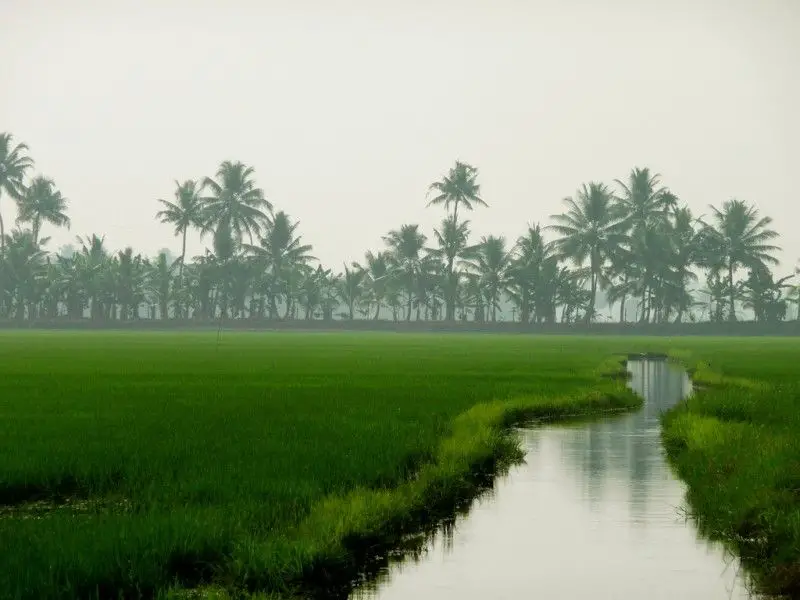
Embark on a journey through the lush, green landscapes of Kuttanad, often referred to as the “Rice Bowl of Kerala.” This idyllic region, crisscrossed by shimmering waterways and adorned with swaying palms, offers a glimpse into the rustic charm and agricultural richness that define the essence of Kerala. Join us as we explore the enchanting Kuttanad village on a tour that promises an immersive experience in the traditional and serene way of life.
A Tapestry of Paddy Fields:
Kuttanad is renowned for its expansive paddy fields, where emerald-green carpets of rice sway in harmony with the gentle breeze. The Kuttanad village tour takes you through these picturesque landscapes, providing an insight into the meticulous and labor-intensive process of paddy cultivation. Witness farmers engaged in traditional farming practices, knee-deep in the fields, as they plant or harvest the staple crop that sustains the region.
Backwaters and Canals:
The meandering backwaters and labyrinthine canals of Kuttanad are the lifeblood of this region. Embark on a serene boat ride through these waterways, passing by quaint villages and witnessing the unhurried pace of everyday life. The tour allows you to appreciate the intricate network of water channels, which not only facilitate transportation but also serve as a source of livelihood for the locals.
Village Homestays:
To truly immerse yourself in the local culture, consider staying in a traditional village homestay. These accommodations offer a glimpse into the warmth and hospitality of Kuttanad’s residents. Share stories with your hosts, savor authentic Kerala cuisine, and wake up to the soothing sounds of nature in these charming homestays.
Traditional Boat Building:
As you meander through the village, you might encounter traditional boat builders crafting Kettuvallams, the iconic houseboats of Kerala. Engage with the artisans, learn about the intricate art of boat building, and witness firsthand the craftsmanship that goes into creating these marvels that grace the backwaters.
Culinary Delights:
No Kuttanad village tour is complete without indulging in the delectable local cuisine. Taste traditional dishes prepared with locally sourced ingredients, and savor the flavors of Kerala. From appam and stew to karimeen pollichathu (pearl spot fish) and kappa (tapioca), the culinary journey is a treat for the taste buds.
Bird Watching in Kumarakom:
Extend your village tour to Kumarakom, a short distance from Kuttanad, to explore the renowned Kumarakom Bird Sanctuary. This sanctuary is a paradise for birdwatchers, offering the chance to spot both migratory and resident bird species in their natural habitat.
Planning Your Tour:
For those planning a Kuttanad village tour, it’s recommended to arrange guided tours with local experts who can provide insights into the culture and history of the region. These tours often include a mix of boat rides, village walks, and visits to key attractions.
Marari Beach Day Trip: A Tranquil Escape on Kerala’s Shores

Escape the ordinary and embark on a day trip to Marari Beach, a hidden gem nestled along the sun-kissed shores of Kerala. Known for its pristine coastline, swaying palms, and laid-back ambiance, Marari Beach promises a rejuvenating escape from the hustle and bustle of everyday life. Join us as we explore the highlights of a day trip to this coastal haven.
Morning Tranquility:
Begin your Marari Beach day trip by immersing yourself in the serene ambiance of the morning. The gentle lull of the waves and the soft rays of the rising sun create a tranquil atmosphere, perfect for a peaceful stroll along the beach. Feel the cool sand beneath your feet and breathe in the fresh sea breeze as you embrace the unhurried pace of Marari.
Yoga by the Shore:
Many resorts and yoga centers near Marari Beach offer morning yoga sessions by the shore. Participate in a rejuvenating yoga class, where the rhythmic sound of the waves serves as a natural soundtrack to your practice. Engage in mindful meditation as you synchronize your breath with the calming rhythm of the sea.
Relaxing Beachfront Breakfast:
As the morning unfolds, treat yourself to a delightful beachfront breakfast at one of the local shacks or resorts. Indulge in the flavors of Kerala with a traditional South Indian breakfast, complete with appam, idiyappam, and a steaming cup of local chai. Enjoy your meal with uninterrupted views of the sea.
Beach Activities:
Marari Beach offers a range of activities for those seeking a bit of adventure. Try your hand at beach volleyball, build sandcastles with the soft golden sand, or simply laze around on a beach chair with a good book. The beach’s gentle slope and shallow waters make it ideal for a refreshing dip.
Fishermen’s Village Exploration:
Take a leisurely stroll to the nearby fishermen’s village to witness the coastal way of life. Observe traditional fishing techniques, visit local markets, and engage with the friendly villagers. The vibrant colors of the fishing boats against the backdrop of the sea create a picturesque scene that reflects the authenticity of Marari.
Ayurvedic Massage:
Indulge in the healing traditions of Kerala with an Ayurvedic massage by the beach. Many resorts and spas in the area offer rejuvenating treatments that incorporate ancient Ayurvedic practices. Let the skilled therapists pamper you as the rhythmic sound of the waves enhances your relaxation.
Lunch with a View:
Savor a delicious seafood lunch at one of the beachside eateries, where the catch of the day is transformed into flavorful dishes. Enjoy the culinary delights of Kerala cuisine while gazing at the endless expanse of the Arabian Sea. Fresh seafood, coconut-infused curries, and local specialties await your taste buds.
Sunset Serenity:
As the day draws to a close, find a serene spot on the beach to witness the mesmerizing sunset. The changing colors of the sky cast a warm glow over Marari, creating a magical atmosphere. Capture the breathtaking views and relish the tranquility of the moment.
Evening Cultural Performances:
Some resorts organize evening cultural performances showcasing traditional Kerala art forms. From Kathakali dance to Mohiniyattam, immerse yourself in the vibrant cultural heritage of the region. The rhythmic beats and colorful costumes add a touch of magic to your Marari Beach day trip.
Kumarakom Bird Sanctuary Visit: A Symphony of Wings in Nature’s Theater
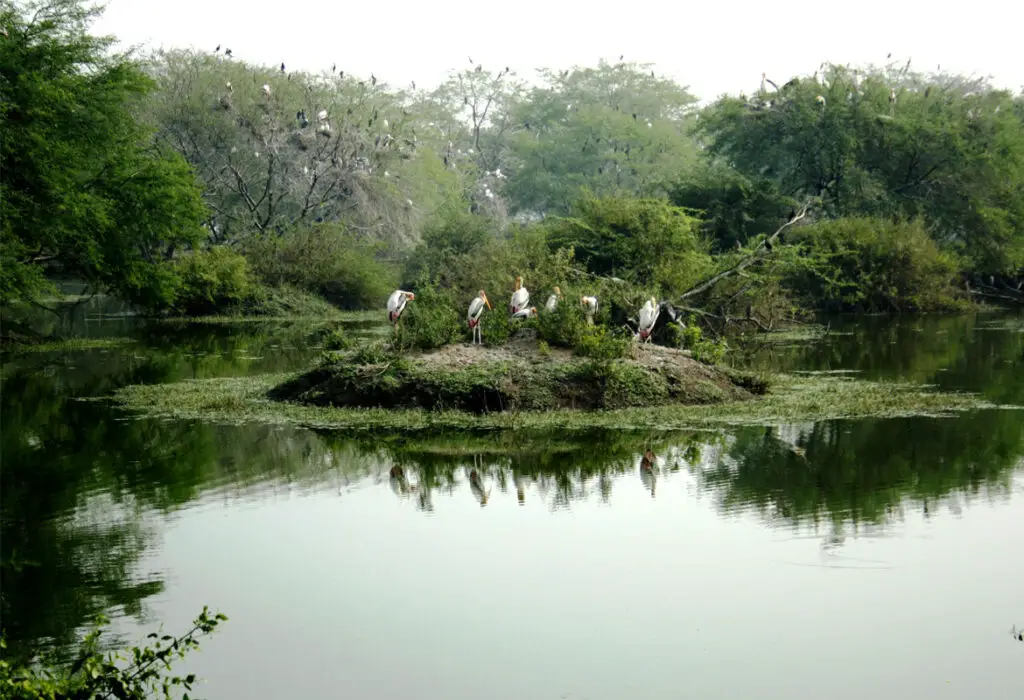
Nestled on the banks of Vembanad Lake, the Kumarakom Bird Sanctuary stands as a testament to the rich avian biodiversity that graces the God’s Own Country, Kerala. A visit to this verdant sanctuary is a journey into a world where the melodious symphony of birdsong and the vibrant colors of feathered inhabitants create an immersive experience for nature enthusiasts. Join us as we explore the enchanting Kumarakom Bird Sanctuary.
Introduction to Avian Haven:
Spread across 14 acres, the Kumarakom Bird Sanctuary is a haven for over a hundred species of local and migratory birds. The lush greenery, interspersed with water bodies and wetlands, provides an ideal habitat for a diverse range of feathered residents.
Birdwatching Extravaganza:
The primary allure of the Kumarakom Bird Sanctuary lies in its prolific birdwatching opportunities. Armed with a pair of binoculars, wander through well-laid trails that wind through the sanctuary. Keep your eyes peeled for vibrant kingfishers, graceful egrets, majestic herons, and the elusive Siberian crane during the migratory season.
Best Time to Visit:
While the sanctuary is open throughout the year, the best time for birdwatching is during the migratory season, which typically occurs from November to February. This is when numerous migratory birds, including the Siberian crane, flock to Kumarakom, adding to the diversity of the avian population.
Iconic Bird Species:
Among the star attractions of the Kumarakom Bird Sanctuary are the Painted Stork, Spot-billed Pelican, Common Teal, Cormorant, and the regal Brahminy Kite. The sanctuary’s diverse ecosystems, including mangrove forests and wetlands, provide ideal breeding grounds for these avian species.
Houseboat Birdwatching Tours:
For a unique birdwatching experience, consider taking a houseboat tour through the Vembanad Lake and its adjoining backwaters. Many houseboat operators offer guided tours where you can observe birds in their natural habitat from the comfort of a traditional Kettuvallam.
Thazhathangadi Juma Masjid:
Adjacent to the sanctuary lies the Thazhathangadi Juma Masjid, an ancient mosque with a unique blend of traditional Kerala and Persian architectural styles. Visiting this religious site adds a cultural dimension to your Kumarakom Bird Sanctuary excursion.
Photography Opportunities:
Photography enthusiasts will find Kumarakom Bird Sanctuary to be a captivating subject. Capture the elegant flight of birds, the reflective stillness of the water, and the vibrant hues of the surroundings. Early mornings and late afternoons provide optimal lighting conditions for stunning photographs.
Boating in Vembanad Lake:
Extend your birdwatching adventure with a boat ride on Vembanad Lake. Sail through the serene waters, enjoying panoramic views of the sanctuary and its feathered inhabitants. Boating allows you to witness the birds in their natural behavior, whether it’s fishing, nesting, or simply enjoying a leisurely glide.
Guided Nature Walks:
For a more in-depth understanding of the sanctuary’s flora and fauna, opt for a guided nature walk. Knowledgeable guides can point out various bird species, explain their behaviors, and provide insights into the unique ecosystems that make Kumarakom Bird Sanctuary a haven for avian life.
Visitor Information:
- Location: Kumarakom, Kottayam District, Kerala, India.
- Timings: 6:30 AM to 5:00 PM (Open all days of the week).
- Entry Fee: Nominal entry fee for adults; concessions for children and students.
Harmony and Healing: The Essence of Ayurvedic Massage in Alappuzha
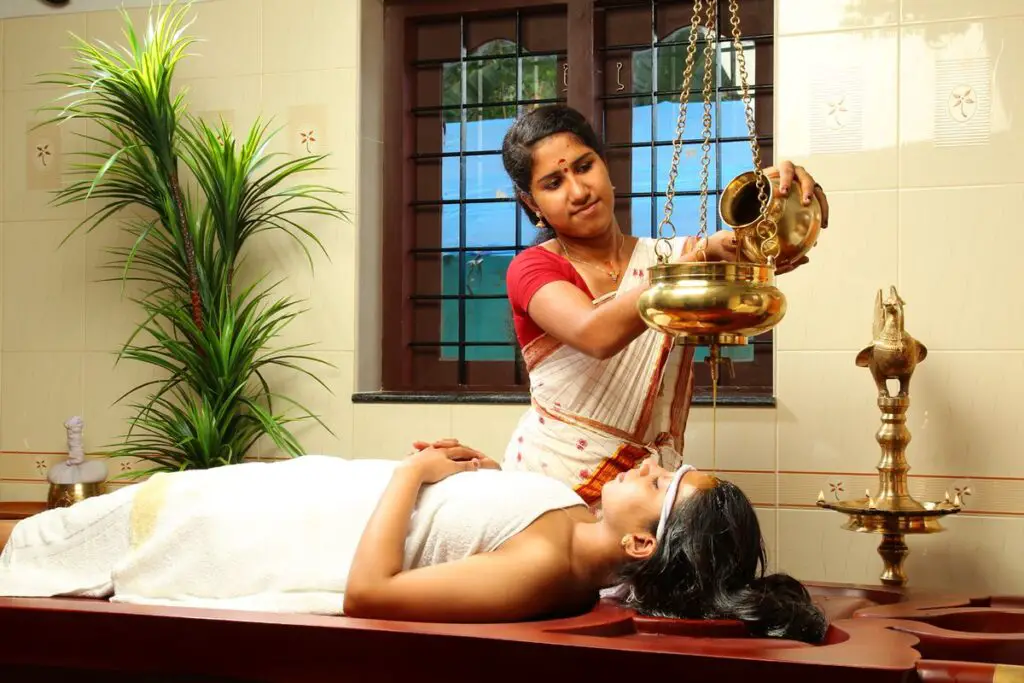
Nestled along the tranquil backwaters of Kerala, Alappuzha beckons travelers with its serene landscapes and a time-honored tradition that has been soothing weary souls for centuries – Ayurvedic massage. More than just a form of relaxation, Ayurvedic massage in Alappuzha is a holistic experience that harmonizes the body, mind, and spirit. Join us on a journey into the world of Ayurveda, where ancient healing techniques meet the gentle rhythm of the backwaters.
The Ayurvedic Tradition:
Ayurveda, the ancient system of holistic healing, has its roots deeply embedded in Indian culture. Alappuzha, with its lush greenery and peaceful ambiance, provides the perfect backdrop for the practice of Ayurvedic therapies. Ayurvedic massage, known as “Abhyanga,” is a cornerstone of this traditional healing system.
Healing Hands of Skilled Therapists:
At Ayurvedic centers in Alappuzha, you will find skilled therapists whose hands are adept at the art of healing. Trained in the ancient techniques passed down through generations, these practitioners tailor each massage to the individual’s unique constitution or dosha, ensuring a personalized and effective therapy session.
Holistic Well-being:
Ayurvedic massage goes beyond the physical realm, aiming to restore balance to the entire being. The massage techniques stimulate vital energy points, promoting better circulation, detoxification, and relaxation. It’s a holistic approach that not only addresses physical ailments but also seeks to harmonize the mental and spiritual aspects of one’s well-being.
Traditional Oils and Herbs:
The key to Ayurvedic massage lies in the use of specially formulated oils infused with herbs chosen for their therapeutic properties. These oils are often prepared according to ancient recipes, and each has its unique benefits. From soothing joint pain to rejuvenating the skin, the choice of oil plays a crucial role in the efficacy of the massage.
Synchronized Strokes and Soothing Rhythms:
During an Ayurvedic massage session, therapists employ a variety of strokes and techniques that are synchronized with the body’s natural rhythms. The gentle yet firm movements work to release tension, improve flexibility, and promote a profound sense of relaxation. The therapeutic touch creates a flow of energy that fosters a state of equilibrium.
Shirodhara – A Unique Experience:
For those seeking an even more immersive experience, Ayurvedic centers in Alappuzha often offer Shirodhara. This therapeutic procedure involves a continuous flow of warm herbal oil onto the forehead, creating a profound sense of calm and tranquility. Shirodhara is renowned for its ability to alleviate stress and promote mental clarity.
Savoring the Afterglow:
Post-massage, it’s customary to allow the therapeutic oils to penetrate the skin for some time before washing them off. This not only enhances the benefits of the massage but also leaves you with a lasting sense of rejuvenation. Many visitors find themselves basking in the afterglow of the massage, feeling both physically and mentally renewed.
Choosing Your Ayurvedic Experience:
Alappuzha offers a range of Ayurvedic centers, each with its unique charm and expertise. Whether you opt for a session at a renowned spa or a traditional Ayurvedic clinic, the experience promises to be a journey into the heart of natural healing.
Precautions and Recommendations:
- Inform the therapist about any health conditions or allergies before the massage.
- Wear comfortable clothing, as Ayurvedic massages often involve the use of therapeutic oils.
- Ensure that you have some downtime after the massage to allow the healing effects to fully manifest.
A Symphony of Paddles: Navigating Alappuzha’s Canals by Kayak and Canoe
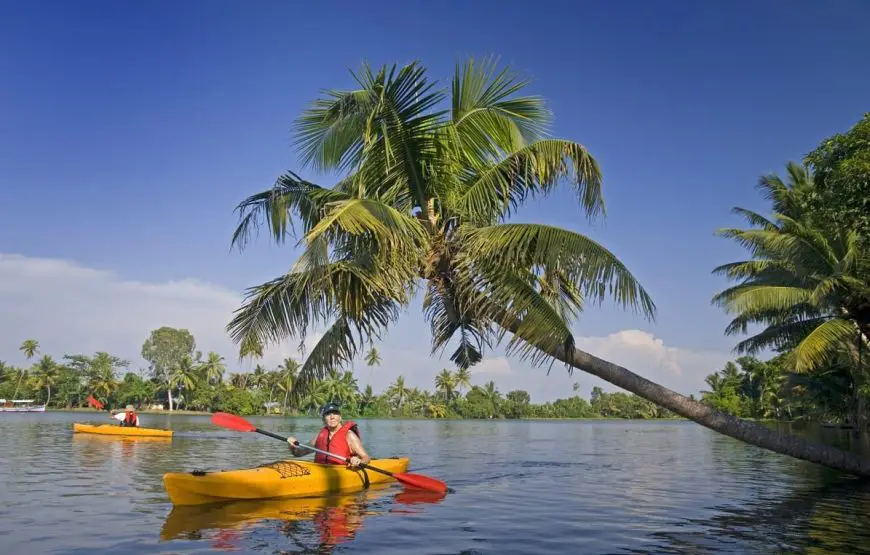
Embark on a unique and immersive journey through the enchanting waterways of Alappuzha, Kerala, where the rhythmic paddling of oars becomes a melody that echoes the essence of this Venice of the East. Paddling through the canals of Alappuzha unveils a side of this picturesque destination that goes beyond the familiar houseboats, offering a serene and up-close encounter with the heart of Kerala’s backwaters.
Choosing Your Vessel:
Whether you opt for a traditional canoe, a modern kayak, or a paddleboard, the canals of Alappuzha welcome all forms of non-motorized vessels. Each offers a unique perspective, allowing you to navigate the narrow waterways with ease and enjoy the tranquility of the surroundings.
Navigating Narrow Canals:
Alappuzha’s intricate network of canals is a marvel to explore. Paddling through narrow canals surrounded by lush greenery and quaint villages provides an intimate view of local life. The gentle strokes of your paddle propel you forward as you navigate the twists and turns, revealing hidden corners of this watery paradise.
Up-Close with Backwater Life:
The slower pace of paddling allows for a more intimate interaction with the backwater communities. Observe villagers engaged in daily activities along the banks, witness traditional fishing techniques, and experience the warmth of local hospitality as you paddle through this living tapestry.
Exploring Uncharted Territories:
While the iconic houseboats glide along the main waterways, paddling opens up avenues to explore lesser-known and quieter canals. Venture into off-the-beaten-path routes, where the only sounds are the soft ripples against your paddle and the occasional call of a passing bird. It’s a chance to savor the serenity away from the more frequented routes.
Birdwatching Extravaganza:
Alappuzha’s backwaters are a haven for birdwatchers, and paddling offers a silent approach to observe the rich avian life. Herons, kingfishers, and cormorants gracefully coexist in this ecosystem. Bring your binoculars, and let the slow glide of your paddle take you to hidden corners where these feathered residents thrive.
Sunset Paddle Magic:
As the sun begins its descent, embark on a magical sunset paddle. The waters of Alappuzha take on a golden hue, and the surrounding landscape is bathed in the warm glow of twilight. Paddling during this enchanting hour is an experience that combines the tranquility of the backwaters with the awe-inspiring beauty of a Kerala sunset.
Paddleboard Yoga:
For those seeking a blend of wellness and adventure, consider a paddleboard yoga session. Many operators in Alappuzha offer guided paddleboard yoga experiences, allowing you to connect with nature and find balance on the gentle ripples of the backwaters.
Organized Tours and Rentals:
Several local operators provide guided paddling tours and equipment rentals. Whether you’re a novice or an experienced paddler, these services cater to various skill levels. Knowledgeable guides often accompany tours, sharing insights into the local ecosystem and ensuring a safe and enjoyable experience.
Essential Tips for Paddlers:
- Wear comfortable and moisture-wicking clothing suitable for the tropical climate.
- Apply sunscreen and carry a hat to protect yourself from the sun.
- Stay hydrated by bringing a reusable water bottle.
- Respect the local communities and wildlife by maintaining a quiet and non-intrusive presence.
St. Mary’s Forane Church, Alappuzha: A Spiritual Odyssey in God’s Own Country

Nestled in the heart of Alappuzha, Kerala, St. Mary’s Forane Church stands as a timeless testament to faith, history, and architectural splendor. Visiting this sacred site is not merely a journey through brick and mortar; it’s an immersion into the rich tapestry of Christian heritage in God’s Own Country. Join us as we explore the spiritual odyssey awaiting those who step into the hallowed grounds of St. Mary’s Forane Church.
A Glimpse into History:
St. Mary’s Forane Church boasts a history that stretches back to the 16th century. The church’s foundation is believed to have been laid by the renowned missionary, St. Thomas, who journeyed to the Malabar Coast to spread the teachings of Christianity. The centuries that followed witnessed the church evolving into a symbol of unwavering faith and cultural significance.
Architectural Grandeur:
As you approach the church, the grandeur of its architecture captivates the senses. The façade, adorned with intricate carvings and Gothic-inspired elements, stands as a testament to the craftsmanship of a bygone era. The blend of European and indigenous architectural styles adds a unique charm to St. Mary’s Forane Church, making it an architectural gem in the heart of Alappuzha.
Spiritual Sanctuary:
Step inside, and you’ll find yourself enveloped in an aura of tranquility and devotion. The interior of St. Mary’s Forane Church is adorned with beautiful stained glass windows, ornate altars, and sacred artwork that narrates biblical stories. The quietude within the church creates a space for reflection and prayer, inviting visitors to connect with their spiritual selves.
Feast of St. Mary:
The annual Feast of St. Mary, celebrated in September, is a vibrant and joyous occasion that draws devotees from near and far. The church comes alive with processions, religious ceremonies, and cultural events during this festive period. Pilgrims and visitors alike gather to partake in the spiritual energy and community festivities.
St. Sebastian’s Chapel:
Adjacent to St. Mary’s Forane Church is the St. Sebastian’s Chapel, an integral part of the spiritual complex. The chapel, dedicated to St. Sebastian, offers a more intimate space for prayer and contemplation. Its architecture mirrors the timeless beauty of the main church.
Paying Homage at the Shrine:
At the heart of St. Mary’s Forane Church is the revered shrine of St. Mary, a focal point for pilgrims seeking solace and divine intervention. The shrine radiates a sense of sanctity, and many visitors find comfort in lighting candles and offering prayers, creating a sacred ambiance within its walls.
Mystique of the Cemetery:
Wandering through the church’s cemetery reveals not only the passage of time but also the stories of countless individuals who found solace and eternal rest within these sacred grounds. The aged tombstones and sepulchers echo the history and spirituality embedded in St. Mary’s Forane Church.
Practical Information:
- Location: St. Mary’s Forane Church, Alappuzha, Kerala, India.
- Mass Timings: Check with the church office for the latest schedule.
- Feast of St. Mary: The annual feast is celebrated in September.
Guidelines for Visitors:
- Dress modestly when visiting the church.
- Maintain a respectful demeanor during religious services.
- Photography inside the church may be restricted during certain times.
Alleppey Backwater Festival: Celebrating the Essence of Kerala’s Waterways
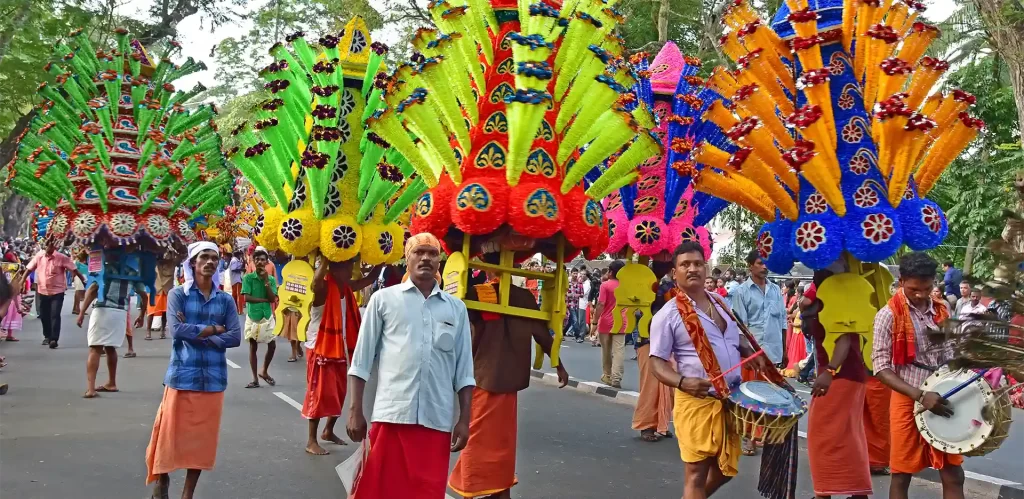
Nestled along the tranquil backwaters of Kerala, Alleppey (Alappuzha) comes alive each year with the vibrant and cultural extravaganza known as the Alleppey Backwater Festival. This celebration, also called the Nehru Trophy Boat Race, is a spectacle that draws visitors from far and wide to witness the thrilling boat races, traditional art forms, and the lively spirit of God’s Own Country. Join us as we delve into the essence of the Alleppey Backwater Festival.
Origins of the Festival:
The Alleppey Backwater Festival finds its roots in a historic event. In 1952, India’s first Prime Minister, Jawaharlal Nehru, visited Alleppey. To welcome him and showcase the traditional boat races of Kerala, the locals organized an impromptu regatta. In honor of Nehru’s visit, he donated a silver trophy, and thus, the Nehru Trophy Boat Race was born.
The Grand Nehru Trophy Boat Race:
The highlight of the Alleppey Backwater Festival is the Nehru Trophy Boat Race, held on the picturesque Punnamada Lake. This grand event takes place on the second Saturday of August every year and features snake boat races, where long, slender boats glide through the water, propelled by the synchronized efforts of hundreds of rowers.
Snake Boats and Team Spirit:
The snake boats, locally known as “chundan vallams,” are iconic symbols of Kerala’s boat races. These boats, often over a hundred feet long, require precise coordination and teamwork. Each boat represents a village, and rowers train rigorously throughout the year to showcase their prowess during the Nehru Trophy Boat Race. The races are not just sporting events but a celebration of unity, community, and tradition.
Cultural Extravaganza:
The Alleppey Backwater Festival extends beyond the boat races, offering a rich cultural experience. Visitors can witness traditional art forms, including Kathakali and Mohiniyattam dances, as well as pulsating performances of traditional music like Chenda Melam. These cultural displays bring to life the vibrant heritage of Kerala and add an immersive layer to the festival.
Floating Processions and Decorated Boats:
A unique aspect of the festival is the spectacular floating processions featuring elaborately decorated boats. Adorned with colorful parasols and traditional motifs, these boats create a visual spectacle on the serene backwaters. The vibrant processions showcase the artistic flair and creativity of the local communities.
Massive Attendance and Enthusiastic Spectators:
The Alleppey Backwater Festival attracts a massive audience, with both locals and tourists converging on the shores of Punnamada Lake to witness the races. The excitement is palpable as spectators cheer for their favorite teams, creating an electric atmosphere that reverberates across the water.
Planning Your Visit:
If you plan to attend the Alleppey Backwater Festival, it’s advisable to make travel arrangements well in advance. Accommodations in Alleppey can fill up quickly during this time, so securing lodging early ensures you can fully immerse yourself in the festivities.
Beyond the Festival:
While the Alleppey Backwater Festival is a major draw, the charm of Alleppey extends throughout the year. The backwaters, houseboat cruises, and serene landscapes make it a captivating destination for those seeking a tranquil escape in the lap of nature.
Pathiramanal Island Excursion: A Tranquil Odyssey Amid Nature’s Splendor

Nestled amidst the pristine waters of Vembanad Lake in Kerala, the quaint Pathiramanal Island stands as a testament to the unspoiled beauty of God’s Own Country. This picturesque isle, which translates to “Sands of Midnight,” offers a serene escape for those seeking a tranquil rendezvous with nature. Join us on a virtual excursion to Pathiramanal Island, where each step unveils a tapestry of lush greenery, diverse birdlife, and the timeless allure of Kerala’s backwaters.
Embarking on a Boat Journey:
The journey to Pathiramanal Island begins with a leisurely boat ride from either Kumarakom or Alappuzha. As the boat gently glides across the shimmering waters of Vembanad Lake, the expansive beauty of the backwaters unfolds, setting the stage for the enchanting island that lies ahead.
A Birder’s Paradise:
Pathiramanal is a haven for bird enthusiasts, with its diverse avian population and migratory species. The island provides a sanctuary for birds like herons, egrets, terns, and pintails. The mesmerizing sight of these feathered inhabitants, whether in flight or perched on the island’s foliage, makes Pathiramanal a true paradise for birdwatching.
Flora and Fauna Delights:
The island is adorned with a lush carpet of greenery, featuring a mix of indigenous and exotic flora. The vibrant colors of flowering plants create a soothing ambiance, making every step a delightful exploration. Keep an eye out for butterflies, dragonflies, and other small wonders that add to the ecological richness of the island.
Pathiramanal’s Mythical Stories:
Aside from its natural beauty, Pathiramanal is steeped in local legends and mythical stories. Locals believe that the island was formed when a young Brahmin dived into the Vembanad Lake to fetch water for performing his daily rituals. Today, the island retains an aura of mystique that adds an extra layer of fascination to the visitor’s experience.
Savoring the Peaceful Atmosphere:
The tranquility of Pathiramanal is one of its most enchanting features. Away from the hustle and bustle of urban life, the island offers a peaceful retreat where visitors can unwind and connect with the serenity of nature. The gentle rustling of leaves, the rhythmic lapping of water, and the harmonious melodies of birds create a symphony of sounds that soothe the soul.
Boatman’s Narratives:
Local boatmen, who serve as guides during the island excursion, often share fascinating anecdotes and stories about Pathiramanal. Their narratives not only provide insights into the island’s natural heritage but also offer glimpses into the daily lives and traditions of the communities that reside along the backwaters.
Ideal Time to Visit:
While Pathiramanal Island is a year-round destination, the winter months from November to February are particularly ideal for birdwatching. During this period, migratory birds from distant lands make their temporary homes on the island, creating a vibrant avian spectacle.
Essentials for the Trip:
- Wear comfortable clothing and sturdy footwear suitable for walking.
- Carry a hat, sunscreen, and insect repellent.
- Bring binoculars and a camera to capture the island’s natural beauty and birdlife.
Mullakkal Rajarajeshwari Temple: A Divine Sojourn in Alappuzha, Kerala
Nestled in the heart of Alappuzha, Kerala, the Mullakkal Rajarajeshwari Temple stands as a divine testament to the spiritual vibrancy and cultural heritage of God’s Own Country. This sacred abode dedicated to the goddess Rajarajeshwari, a form of the divine feminine, beckons visitors with its architectural grandeur, religious significance, and the serene ambiance that envelops its sacred precincts. Join us on a virtual journey to explore the spiritual wonders of the Mullakkal Rajarajeshwari Temple.
Ancient Roots and Mythical Significance:
The Mullakkal Rajarajeshwari Temple boasts a rich history dating back centuries. Steeped in myth and legend, the temple is believed to have been consecrated by the legendary Parasurama, an avatar of Lord Vishnu. The presiding deity, Rajarajeshwari, is revered as the protector and bestower of blessings, embodying the divine feminine energy.
Architectural Splendor:
As you approach the temple, its architectural magnificence captivates the senses. The intricate carvings, vibrant hues, and distinctive Dravidian architectural elements create a visual spectacle. The gopuram (tower) adorned with sculptures of deities and mythological figures welcomes devotees and visitors alike into the spiritual realm of the temple.
Spiritual Sanctum:
Step inside the temple, and you’ll be enveloped in an atmosphere of reverence and devotion. The sanctum sanctorum houses the idol of Rajarajeshwari, adorned with divine ornaments and surrounded by an aura of sacredness. Devotees offer prayers and seek the blessings of the goddess, believing in her power to bestow prosperity, protection, and well-being.
Festivals and Celebrations:
The Mullakkal Rajarajeshwari Temple comes alive during festivals, with vibrant processions, cultural performances, and religious ceremonies. The annual Mullakkal Chirappu, celebrated in the Malayalam month of Kumbham (February-March), is a grand spectacle that attracts devotees and tourists. The temple’s surroundings buzz with activity and joyous festivities during this auspicious time.
Mullakkal Chirappu – A Grand Celebration:
Mullakkal Chirappu marks the culmination of a 41-day-long annual festival. The highlight is the procession of adorned elephants, traditional music performances, and the ceremonial offerings to the goddess. Pilgrims from different parts of Kerala and beyond gather to participate in the religious fervor and witness the divine blessings.
Surrounding Divine Entities:
Adjacent to the main shrine, the temple complex houses sanctums dedicated to other deities, including Lord Ganesha and Nagaraja (serpent god). Devotees often visit these smaller shrines to offer prayers and seek blessings from the diverse divine entities present within the temple precincts.
Temple Pond and Serenity:
A traditional feature of many Kerala temples, the temple pond, or Pushkarini, adds to the spiritual charm of Mullakkal Rajarajeshwari Temple. Devotees believe that taking a ceremonial dip in the holy pond purifies the soul. The serene surroundings and the reflection of the temple in the clear waters create a tranquil setting for contemplation.
Visiting Guidelines:
- Dress modestly, covering shoulders and knees, when entering the temple.
- Remove footwear before entering the sanctum sanctorum.
- Respect the rituals and traditions of the temple.
Chavara Bhavan: A Spiritual Pilgrimage to the Legacy of Saint Kuriakose Elias Chavara
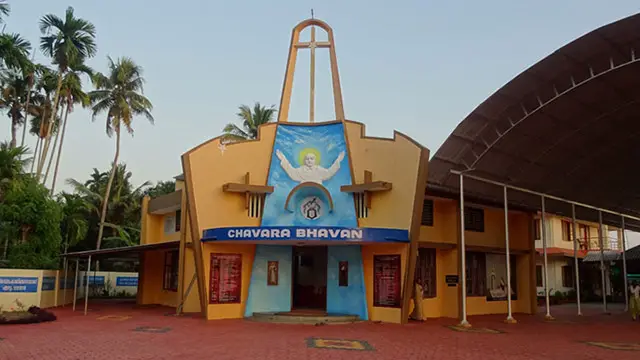
Nestled on the shores of the tranquil Vembanad Lake in Alappuzha, Kerala, Chavara Bhavan stands as a sacred haven, echoing the spiritual resonance of Saint Kuriakose Elias Chavara. This revered pilgrimage site invites visitors to embark on a journey into the life and legacy of a saint who left an indelible mark on Kerala’s religious and educational landscape.
The Legacy of Saint Kuriakose Elias Chavara:
Chavara Bhavan is dedicated to Saint Kuriakose Elias Chavara, a visionary saint, educator, and social reformer who played a pivotal role in the cultural and educational renaissance of Kerala during the 19th century. Saint Chavara was one of the founding fathers of the CMI (Carmelites of Mary Immaculate) congregation, and his teachings continue to inspire millions.
Historical Roots:
Chavara Bhavan was the ancestral home of Saint Kuriakose Elias Chavara and his family. The dwelling, converted into a shrine and museum, preserves the humble beginnings of the saint and provides an intimate glimpse into the socio-religious milieu of 19th-century Kerala.
Journey Through the Saint’s Life:
The pilgrimage to Chavara Bhavan is a profound journey through the life of Saint Chavara. The museum within the premises showcases artifacts, manuscripts, and personal belongings of the saint, offering visitors a chronological narrative of his life, teachings, and contributions to society.
Saint Chavara’s Contributions:
Saint Kuriakose Elias Chavara was a trailblazer in various fields. He was instrumental in the establishment of the first indigenous religious congregation for men in India, the CMI, which later played a vital role in the fields of education and social welfare. The saint’s emphasis on education and moral values laid the foundation for numerous schools and institutions across Kerala.
The Chapel of Saint Chavara:
At Chavara Bhavan, the serene chapel dedicated to Saint Chavara serves as a place of prayer and reflection. Pilgrims and visitors find solace in the quietude of the chapel, where the saint’s spirit seems to linger, guiding those who seek inspiration and divine intervention.
Spiritual Practices and Pilgrimages:
Devotees often engage in spiritual practices and pilgrimages to Chavara Bhavan, seeking the saint’s blessings for their endeavors. The tranquil ambiance of the surroundings, coupled with the deep spiritual resonance of the saint’s life, creates an atmosphere conducive to contemplation and prayer.
The Tomb of Saint Chavara:
The final resting place of Saint Chavara is a sacred spot within the complex. Pilgrims pay their respects at the tomb, and many believe in the saint’s intercession for their prayers and supplications.
Educational and Cultural Initiatives:
Chavara Bhavan not only serves as a spiritual center but also actively engages in educational and cultural initiatives. The institutions founded by Saint Chavara and the CMI congregation continue to contribute to the educational and cultural fabric of Kerala.
Practical Information:
- Location: Chavara Bhavan, Alappuzha, Kerala, India.
- Visiting Hours: It is advisable to check the official schedule and timings before planning your visit.
- Attire: Visitors are expected to dress modestly when visiting the chapel and sacred spaces.
Alleppey Lighthouse: A Beacon of Heritage and Panoramic Views
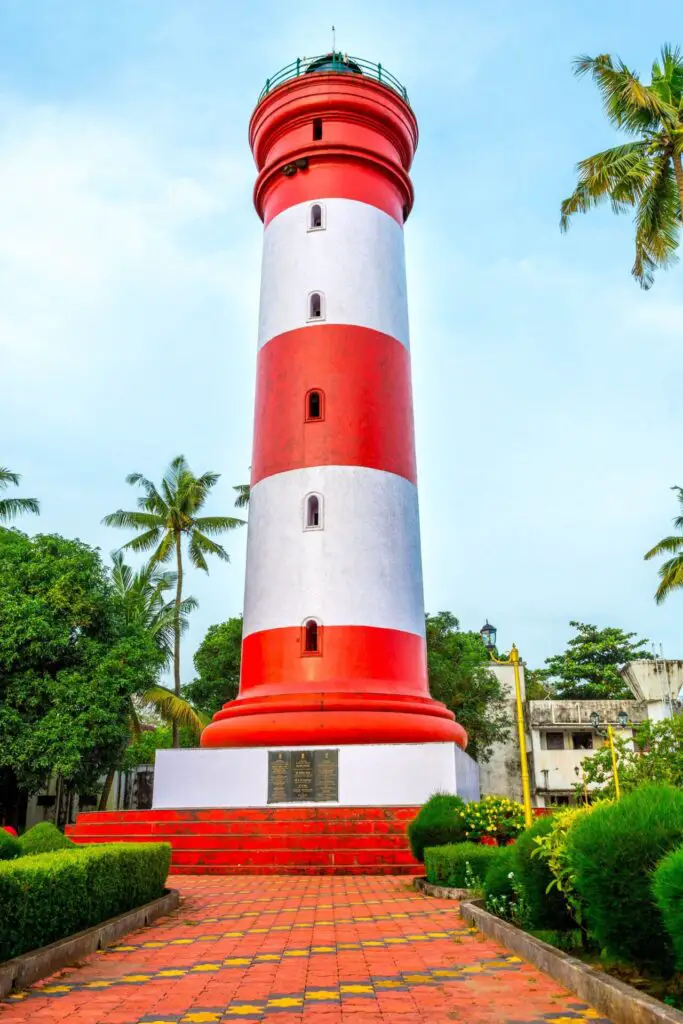
Perched majestically on the scenic coastline of Alleppey (Alappuzha), the Alleppey Lighthouse stands as a sentinel, not only guiding ships safely to harbor but also offering visitors a breathtaking panorama of the Arabian Sea and the picturesque landscapes of Kerala. This iconic structure weaves together maritime history, architectural splendor, and panoramic views, making it a must-visit destination for those exploring God’s Own Country.
Navigating History:
The Alleppey Lighthouse, dating back to 1862, is a living testament to Kerala’s maritime legacy. Originally constructed to guide ships and vessels along the treacherous coastline, the lighthouse has witnessed the ebb and flow of time. Over the years, it has evolved into a symbol of Alleppey’s rich maritime heritage.
Architectural Marvel:
The lighthouse, a red and white striped cylindrical tower, stands tall at approximately 30 meters. Its architectural design reflects a blend of colonial influences and indigenous craftsmanship. As you ascend the spiraling staircase, the historical resonance of the structure becomes palpable, creating a unique connection between the present and the past.
Panoramic Vistas from the Top:
The real magic of the Alleppey Lighthouse unfolds at its summit. A climb to the top rewards visitors with breathtaking panoramic views of the Arabian Sea, the expansive backwaters, and the lush greenery that defines the coastal landscape. The azure waters meeting the verdant shores create a visual symphony that leaves an indelible mark on every observer.
Sunset Spectacle:
One of the most enchanting experiences at the Alleppey Lighthouse is witnessing the sunset from its elevated vantage point. As the sun gracefully descends, casting hues of orange and pink across the horizon, the entire coastal stretch transforms into a canvas of celestial art. The lighthouse provides an ideal perch to savor this daily spectacle.
Visiting Practicalities:
- Location: Alleppey Lighthouse, Alappuzha, Kerala, India.
- Timings: The lighthouse is usually open to visitors from morning to evening. It’s advisable to check the specific timings before planning your visit.
- Entry Fee: A nominal entry fee is charged for adults, with discounts for children and students.
Historical Significance:
The Alleppey Lighthouse is not just a scenic attraction; it carries historical significance as well. Over the years, it has witnessed changes in maritime technology and played a crucial role in ensuring the safety of seafarers navigating the coastal waters. The preservation of this heritage site is a nod to Alleppey’s enduring connection with the sea.
Preservation Efforts:
The maintenance and preservation of the Alleppey Lighthouse are commendable. The lighthouse is a protected monument, and efforts are continually made to ensure that its structural integrity is maintained. The conservation work ensures that future generations can also marvel at this beacon of history.
Local Flavors and Nearby Attractions:
After descending from the lighthouse, explore the nearby coastal areas, where you can savor local delicacies and experience the vibrant culture of Alleppey. The beach, with its golden sands, provides a serene backdrop for a leisurely stroll.
Savoring the Soul of Kerala: A Culinary Odyssey in Alappuzha

As you meander through the picturesque waterways and backwaters of Alappuzha, your senses are beckoned not only by the scenic beauty but also by the tantalizing aromas wafting through the air. Alappuzha, nestled in the heart of Kerala, is not just a visual treat; it is a gastronomic delight that invites you to embark on a culinary odyssey through the rich tapestry of traditional Kerala cuisine.
The Essence of Kerala Cuisine:
Kerala’s culinary heritage is a reflection of its diverse cultural influences, geographical abundance, and a penchant for aromatic spices. Alappuzha, with its proximity to the coast and lush hinterlands, offers a unique blend of flavors that characterize the traditional cuisine of God’s Own Country.
Staples of Kerala Cuisine:
1. Rice and Grains:
At the heart of Kerala’s culinary landscape is rice, the staple grain that forms the basis of many traditional dishes. Whether it’s the fragrant Malabar biryani or the comforting rice-based appams, the versatility of rice showcases the culinary prowess of the region.
2. Coconut:
Coconut, in its various forms—coconut milk, grated coconut, and coconut oil—adds a distinct richness to Kerala’s dishes. From creamy coconut-based curries to coconut-infused desserts, the use of this tropical fruit is a hallmark of Kerala cuisine.
3. Spices and Flavors:
Kerala is renowned for its spice plantations, and the aromatic blend of spices defines its culinary identity. Cardamom, cinnamon, cloves, and black pepper create a symphony of flavors in curries, stews, and seafood dishes.
Must-Try Dishes in Alappuzha:
1. Karimeen Pollichathu:
A quintessential dish of Alappuzha, Karimeen Pollichathu features pearl spot fish marinated in a blend of spices, wrapped in banana leaves, and pan-fried to perfection. The result is a tantalizing harmony of flavors.
2. Kerala Sadya:
For an immersive experience, indulge in a traditional Kerala Sadya—a sumptuous feast served on a banana leaf. Sadya includes an array of vegetarian dishes, pickles, and desserts, offering a kaleidoscope of flavors in a single sitting.
3. Alleppey Fish Curry and Rice:
The coastal influence is evident in Alleppey’s fish curry, where locally caught fish is simmered in a tangy tamarind and coconut milk base, creating a symphony of flavors that pairs perfectly with steamed rice.
4. Appam with Stew:
Soft, lacy appams, made from fermented rice batter, are often paired with a delectable stew. The stew features vegetables, meat, or seafood simmered in coconut milk, resulting in a light yet flavorful dish.
Charming Eateries and Local Joints:
1. Indian Coffee House:
A nostalgic throwback to an era gone by, the Indian Coffee House in Alappuzha offers not only aromatic coffee but also a taste of Kerala’s culinary classics, including appams and egg curry.
2. Thaff Restaurant:
For those seeking an authentic local experience, Thaff Restaurant serves up traditional Kerala meals, from spicy curries to delicious seafood, in a no-frills setting.
Cooking Classes and Culinary Experiences:
Immerse yourself in the art of Kerala cooking by participating in local cooking classes. Many establishments in Alappuzha offer hands-on experiences, allowing you to learn the intricacies of traditional recipes from seasoned chefs.
Alleppey CSI Christ Church: A Testament of Faith and Architectural Grandeur

Nestled in the heart of Alleppey, the CSI Christ Church stands as a graceful testament to both the spiritual heritage and architectural elegance of Kerala. This historic church, affiliated with the Church of South India (CSI), invites visitors to embark on a journey through time, combining religious reverence with the appreciation of timeless craftsmanship.
Historical Roots:
The CSI Christ Church, also known as the Church of South India Alleppey Church, has a rich history dating back to the 19th century. Established by the British in 1816, the church has witnessed the ebb and flow of time, silently echoing the stories of the community it has served for generations.
Architectural Splendor:
As you approach the CSI Christ Church, the architectural grandeur of this colonial-era structure captivates the senses. The church seamlessly blends Gothic and traditional Kerala architectural styles, creating a harmonious synthesis of cultural influences. The pointed arches, stained glass windows, and intricately carved wooden furniture showcase the craftsmanship of a bygone era.
Elegance in Design:
The church’s interior is adorned with ornate wooden furnishings, intricate carvings, and a soaring nave that evokes a sense of sacred space. The pointed arches, a hallmark of Gothic architecture, add a touch of European elegance to the traditional Kerala design elements, creating a unique and visually captivating ambiance.
Spiritual Atmosphere:
Step inside the CSI Christ Church, and you are enveloped in a spiritual atmosphere. The quietude within, punctuated by occasional hymns and prayers, offers a sanctuary for reflection and contemplation. The church’s simple yet elegant altar becomes the focal point for congregational worship.
Stained Glass Artistry:
The stained glass windows of the CSI Christ Church are a highlight, depicting biblical scenes and religious motifs. The interplay of colored light filtering through the intricate glasswork adds a mystical touch to the worship space, creating a visual narrative that complements the spoken word.
Church Grounds and Cemetery:
The church is surrounded by well-maintained grounds, providing a tranquil space for introspection. The cemetery adjacent to the church tells stories of the individuals and families who were an integral part of Alleppey’s history, their gravestones adorned with weathered yet eloquent inscriptions.
Religious Services:
The CSI Christ Church continues to be an active place of worship, hosting regular religious services and events. Visitors are welcome to join in the congregational prayers, adding a participatory dimension to their exploration of the church’s spiritual legacy.
Community Engagement:
Beyond its religious services, the CSI Christ Church plays an active role in community engagement. The church organizes various social and cultural events, fostering a sense of community among its members and contributing to the well-being of the local populace.
Preservation and Restoration:
Efforts to preserve and restore the CSI Christ Church are ongoing, ensuring that its architectural and historical significance is passed on to future generations. Preservation initiatives not only maintain the structural integrity of the church but also contribute to the cultural heritage of Alleppey.
Practical Information:
- Location: CSI Christ Church, Near Iron Bridge, Alleppey, Kerala, India.
- Visiting Hours: It is advisable to check the church’s schedule for visiting hours and any special events.
Alleppey Sailing Club: Navigating Tranquility in God’s Own Country
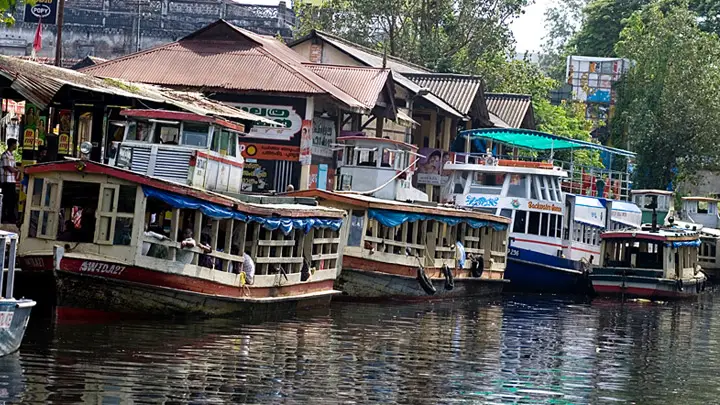
Nestled on the serene shores of Alappuzha, the Alleppey Sailing Club emerges as more than a recreational hub—it’s a gateway to the tranquil waters that define the beauty of Kerala. In the heart of God’s Own Country, this club offers a unique blend of sailing adventures, picturesque landscapes, and a community spirit that beckons both seasoned sailors and novices seeking a maritime escapade.
A Sailors’ Paradise:
The Alleppey Sailing Club, with its idyllic location on the Vembanad Lake, provides an enchanting setting for sailing enthusiasts. The expansive lake, fringed by lush greenery and swaying palms, serves as the perfect canvas for those eager to navigate its tranquil waters.
Sailing Courses for All:
Whether you’re a seasoned sailor or a novice yearning to learn the ropes, the Alleppey Sailing Club offers courses that cater to all skill levels. Experienced instructors guide beginners through the basics, instilling a love for sailing and ensuring a safe and enjoyable experience on the water.
Regattas and Competitions:
For those who thrive on the thrill of competition, the sailing club organizes regattas and races that add an exciting dimension to the tranquil waters. These events attract participants from across the region, fostering a sense of camaraderie and sportsmanship among sailing enthusiasts.
Alleppey Sailing Club House:
The club’s headquarters, often referred to as the “clubhouse,” is a hub of activity. Boasting a relaxed and welcoming atmosphere, the clubhouse serves as a meeting point for sailors to share experiences, discuss techniques, and plan their next ventures on the lake.
Community Bonding:
What sets the Alleppey Sailing Club apart is the strong sense of community it fosters. Beyond the sails and competitions, members often come together for social gatherings, cultural events, and collaborative efforts to promote environmental conservation in the pristine backwaters.
The Joy of Sunset Sails:
As the sun begins its descent, casting hues of orange and pink across the horizon, the Alleppey Sailing Club offers members the enchanting experience of sunset sails. Drifting on the tranquil waters, participants witness the breathtaking spectacle of the sun bidding adieu to another day, casting a warm glow over the expansive lake.
Alleppey Sailing Club and Tourism:
For tourists seeking a unique experience in Alappuzha, the sailing club offers day sails and short courses. This allows visitors to not only enjoy the beauty of the backwaters but also gain hands-on experience in steering a sailboat under the guidance of skilled instructors.
Practical Information:
- Location: Alleppey Sailing Club, Punnamada, Alappuzha, Kerala, India.
- Courses: Check with the club for information on sailing courses, schedules, and fees.
- Membership: The club offers both annual and temporary memberships for those interested in becoming part of the sailing community.
Preserving Nature’s Beauty:
The Alleppey Sailing Club recognizes the importance of preserving the pristine environment that surrounds it. Members actively engage in initiatives to promote responsible tourism and environmental awareness, ensuring that future generations can continue to enjoy the beauty of the Vembanad Lake.
Mannarasala Nagaraja Temple: A Serpent Sanctuary Amidst Sacred Groves
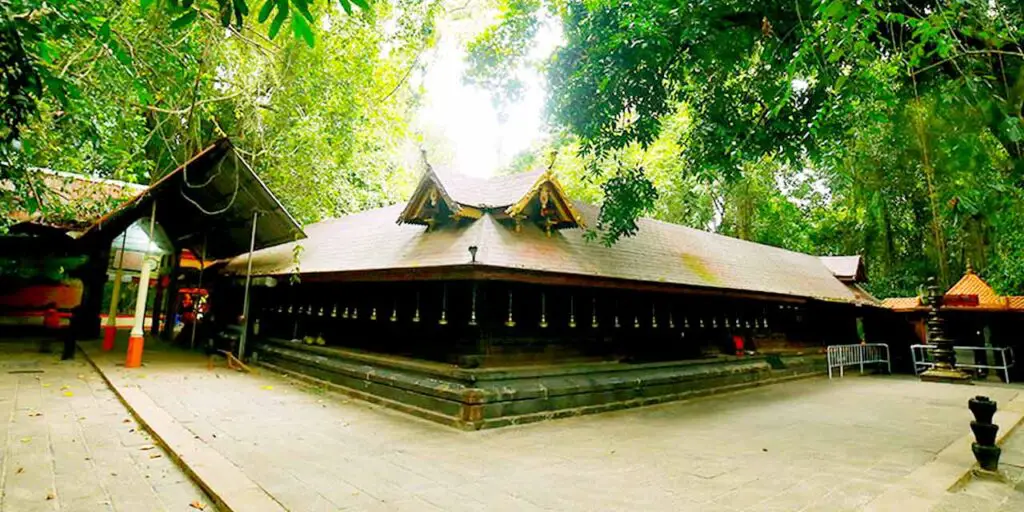
Nestled in the sylvan landscapes of Haripad in Kerala, the Mannarasala Nagaraja Temple stands as a unique pilgrimage destination, shrouded in myths, spirituality, and a serenity that echoes through the ancient groves. This temple, dedicated to Nagaraja, the serpent deity, offers not only a spiritual haven but also an opportunity to witness the harmonious coexistence of devotees and the serpentine residents of the sacred groves.
Mythical Origins:
The Mannarasala Nagaraja Temple is steeped in mythology, with its origins intertwined with the legendary sage Parashurama. According to folklore, Parashurama, seeking to redeem himself of the sin of matricide, installed the deity Nagaraja and initiated the worship at this sacred site. The temple’s history and rituals are thus intricately connected to the mythical narrative of Parashurama’s penance.
Serpentine Sanctity:
What sets Mannarasala apart is its unique focus on serpent worship. The temple is renowned for its serene ambiance, where numerous serpent idols are enshrined amidst lush greenery. Devotees believe that the serpent deities, symbolizing fertility and protection, have a benevolent influence on their lives.
Sacred Groves and Biodiversity:
The temple complex includes pristine sacred groves, providing a natural habitat for a variety of flora and fauna. Tall trees, moss-covered rocks, and meandering pathways create an enchanting setting for devotees and nature enthusiasts alike. The coexistence of the temple and the biodiversity of the sacred groves reflects Kerala’s commitment to preserving its ecological heritage.
Rituals and Offerings:
Devotees visit Mannarasala to seek blessings for fertility, prosperity, and overall well-being. Special pujas and rituals dedicated to Nagaraja are conducted, and offerings of turmeric paste, flowers, and traditional lamps are made as acts of devotion. The belief in the protective and nurturing powers of the serpent deities permeates every aspect of temple worship.
Turmeric Abhishekam:
A unique ritual at Mannarasala is the ‘Turmeric Abhishekam,’ where the main deity is bathed in a sacred mixture of turmeric and other herbal ingredients. This ritual, performed with great reverence, symbolizes purification and the bestowing of healing energy.
Mandala Puja:
The temple observes a 41-day Mandala Puja during the Malayalam month of Vrischikam (November-December). Devotees undertake rigorous vows and penance during this period, culminating in a grand procession and the ‘Mannarasala Ayilyam’ festival.
Mannarasala Ayilyam Festival:
The Mannarasala Ayilyam festival, held annually, is a grand celebration that attracts pilgrims from far and wide. The festival features ceremonial processions, traditional music, and dance performances, creating a vibrant tapestry of cultural and religious festivities.
Preservation of Traditions:
Efforts to preserve the cultural and ecological significance of Mannarasala are evident in the initiatives taken by the temple authorities. The Mannarasala Conservation Committee focuses on maintaining the sanctity of the sacred groves and promoting awareness about the importance of biodiversity conservation.
Visiting Mannarasala Nagaraja Temple:
- Location: Mannarasala Nagaraja Temple, Haripad, Alappuzha, Kerala, India.
- Visiting Hours: The temple is usually open to visitors from morning to evening. It’s advisable to check the specific timings before planning your visit.
- Attire: Devotees are expected to dress modestly when entering the temple premises.
Discovering the Art of Coir: A Fascinating Tour of Alleppey’s Coir Factories
Alleppey, also known as Alappuzha, not only enchants visitors with its serene backwaters but also introduces them to the age-old craft of coir weaving. The coir industry, deeply rooted in the cultural fabric of Kerala, finds its epicenter in Alleppey. Embarking on a coir factory tour unveils the intricate process of transforming coconut fibers into versatile and eco-friendly products, providing a captivating glimpse into the local economy and craftsmanship.
Introduction to Coir:
Derived from the husk of coconuts, coir is a versatile natural fiber known for its strength, durability, and eco-friendly properties. In Alleppey, the coir industry has flourished, becoming a significant contributor to the region’s economy. A coir factory tour allows visitors to witness firsthand the various stages of coir production.
Harvesting and Processing:
The coir manufacturing process commences with the extraction of coconut husks. Skilled workers adeptly strip the husks from coconuts, a task that requires precision and experience. These husks are then soaked in water to facilitate the extraction of coir fibers.
Retting and Drying:
The soaked coir husks undergo a process called retting, during which they are left to soak in water for an extended period. This natural fermentation process loosens the fibers, making them easier to extract. After retting, the coir fibers are meticulously dried in the sun, embracing the abundant sunlight that graces Kerala.
Spinning and Weaving:
Once dried, the coir fibers are spun into yarn using traditional spinning wheels. The skillful hands of artisans deftly transform the fibers into threads, ready for the looming process. The weaving of coir carpets, mats, and other products requires both precision and creativity, as artisans bring life to their designs.
Dyeing and Finishing:
For those seeking a burst of color, the dyeing process adds vibrancy to coir products. Artisans skillfully apply natural and eco-friendly dyes, ensuring that the final products remain in harmony with the environment. The finishing touches involve trimming, shaping, and quality checks before the coir creations are ready for market.
Variety of Coir Products:
A coir factory tour showcases an array of products crafted from this versatile fiber. Coir mats, rugs, carpets, brushes, and even intricately woven coir furniture are on display. Visitors can witness the diversity of coir applications, each product a testament to the artisans’ craftsmanship.
Sustainability and Eco-Friendly Practices:
One of the remarkable aspects of the coir industry in Alleppey is its commitment to sustainability. Coir is a renewable resource, and the production process typically employs eco-friendly practices. The absence of harmful chemicals in the dyeing process adds to the environmental appeal of coir products.
Interactive Workshops and Demonstrations:
Some coir factories in Alleppey offer interactive workshops and demonstrations for visitors. These sessions provide hands-on experiences, allowing participants to try their hand at spinning coir fibers or weaving simple patterns. It’s a delightful way to appreciate the intricacies of this traditional craft.
Shopping for Souvenirs:
No coir factory tour is complete without a visit to the on-site stores. Here, visitors can browse through a plethora of coir products, from functional items like doormats to aesthetically pleasing home decor. Purchasing coir souvenirs not only supports local artisans but also allows visitors to take home a piece of Kerala’s cultural heritage.
Practical Information:
- Location: Various coir factories in and around Alleppey, Kerala, India.
- Tour Timings: It’s advisable to check with individual factories for their tour schedules and any special events or workshops.
Serenity on the Backwaters: Navigating Alleppey’s Shikara Boats
In the heart of Kerala’s enchanting backwaters lies Alleppey, a place of tranquil waterways, verdant landscapes, and an age-old tradition of Shikara boat rides. Riding the Shikara boats in Alleppey is not just a means of transportation but a journey into the soul of God’s Own Country, where every ripple tells a story and every moment is a brushstroke on the canvas of serene waters.
Shikara Boats: Icons of Tranquility
The Shikara boats of Alleppey are synonymous with leisurely journeys along the intricate network of canals, lagoons, and lakes. These traditional wooden boats, elegantly crafted and adorned with vibrant colors, offer a comfortable and intimate setting for exploring the backwaters. The distinct design of Shikara boats, with their flat bottoms and arched roofs, evokes a sense of timeless charm.
Traversing the Backwaters: A Symphony of Sights and Sounds
As you embark on a Shikara boat ride, the first thing that captures your senses is the rhythmic sound of oars slicing through the water. The boat glides smoothly, allowing you to absorb the scenic beauty that unfolds on both sides. Lush green paddy fields, swaying coconut palms, and quaint villages create a picturesque panorama that seems to exist outside the bounds of time.
Village Life Unveiled:
The meandering canals take you through traditional villages where life unfolds at a languid pace. Witness locals engaged in everyday activities – women washing clothes by the water’s edge, fishermen casting their nets, and children playing along the shores. It’s a glimpse into the unhurried rhythm of rural life in Kerala.
Birdsong and Nature’s Symphony:
Alleppey’s backwaters are a haven for birdwatchers and nature enthusiasts. The Shikara boat ride becomes a moving platform for birdwatching, as you spot vibrant kingfishers, majestic herons, and the occasional eagle. The air is filled with the melodious chirping of birds, creating a harmonious symphony that adds to the overall serenity.
Floating Markets and Local Flavors:
Some Shikara boat rides take you to floating markets where local vendors ply their trade from small boats laden with fresh produce. This immersive experience allows you to interact with the locals, buy authentic Kerala spices, and savor the flavors of coconut-infused cuisine.
Sunset Magic on the Backwaters:
One of the most magical moments during a Shikara boat ride is witnessing the sunset over the backwaters. As the sun dips below the horizon, the sky is painted in hues of orange, pink, and purple, casting a warm glow over the tranquil waters. It’s a spectacle that etches itself into your memory.
Private Shikara Tours:
For a more personalized experience, private Shikara tours are available, allowing you to tailor your journey according to your preferences. Whether it’s a romantic escapade, a family adventure, or a solo contemplative ride, the Shikara boats cater to diverse experiences.
Practical Information:
- Location: Various starting points in Alleppey, Kerala, India.
- Duration: Shikara boat rides typically range from one to several hours, depending on the route chosen.
- Best Time to Visit: The backwaters are at their scenic best during the post-monsoon season (October to March).
Alleppey Heritage Walk: A Stroll Through Time and Culture
Nestled along the tranquil backwaters of Kerala, Alleppey not only captivates with its scenic beauty but also unfolds a rich tapestry of history and culture. The Alleppey Heritage Walk invites visitors to embark on a journey through time, meandering through the narrow lanes of the old town, exploring ancient structures, and immersing themselves in the vibrant stories that echo through the bylanes of this coastal gem.
Exploring Alleppey’s Old Quarter:
The Heritage Walk begins in the heart of Alleppey’s old quarter, where colonial-era architecture and traditional Kerala structures coexist in a charming ensemble. The narrow streets, flanked by heritage buildings and quaint shops, transport visitors to an era when Alleppey was a bustling hub of trade and culture.
St. Mary’s Syro-Malabar Catholic Church: A Spiritual Haven:
The walk takes a spiritual turn as it reaches St. Mary’s Syro-Malabar Catholic Church, an ancient place of worship that reflects the cultural amalgamation of Kerala. The church’s intricate architecture and serene ambiance make it a peaceful retreat for locals and visitors alike.
Colonial Residences and Dutch Influence:
Alleppey’s heritage walk unveils colonial-era residences that showcase Dutch and Portuguese architectural influences. The ornate facades, wooden balconies, and tiled roofs transport walkers to a time when these structures stood witness to the comings and goings of traders and explorers.
Alleppey Public Library: A Literary Pause:
For those inclined towards knowledge, the heritage walk leads to the Alleppey Public Library. This colonial-era institution houses a treasure trove of books, manuscripts, and artifacts, offering a glimpse into Alleppey’s intellectual heritage.
Local Markets and Cultural Encounters:
The narrow lanes of Alleppey’s old town also lead to vibrant local markets. Here, the heritage walk transforms into a cultural odyssey as visitors interact with traders, taste local delicacies, and witness traditional crafts being practiced with skill and precision.
Practical Information:
- Starting Point: The heritage walk can begin at various points in the old town. Local guides or maps are available to assist visitors.
- Duration: The walk’s duration can vary based on individual preferences and the sites visited.
- Footwear and Attire: Comfortable footwear is advisable as some parts of the walk might involve uneven terrain. Dress modestly, especially when visiting religious sites.
Witnessing the Grace and Power: Watching Kalaripayattu in Alappuzha

In the cradle of Kerala’s cultural heritage, Alappuzha emerges as a gateway to a mesmerizing display of ancient martial arts prowess — Kalaripayattu. More than just a performance, watching a Kalaripayattu show in Alappuzha is an immersive journey into the rhythmic cadence of strikes, the fluidity of movements, and the profound cultural heritage embedded in every gesture.
The Ancient Art of Kalaripayattu:
Kalaripayattu, often hailed as one of the world’s oldest martial arts, finds its origins in the rich tapestry of Kerala’s traditions. Developed over millennia, this art form encompasses physical combat, weaponry, healing techniques, and a holistic approach to physical and mental well-being.
Choosing Alappuzha for Kalaripayattu:
Alappuzha, with its cultural vibrancy and historical significance, provides an ideal setting for experiencing the grandeur of Kalaripayattu. Visitors to this coastal town can witness the art form’s dynamic expressions at various venues, each contributing to the narrative of Kerala’s martial heritage.
The Artistry of Combat:
As the rhythmic beats of traditional percussion instruments set the stage, Kalaripayattu performers, known as Kalari Warriors, step into the arena. The showcase of dynamic movements, intricate postures, and weapon mastery unfolds like a visual symphony, blending strength, agility, and precision.
Traditional Attire and Symbolism:
Dressed in vibrant traditional attire, Kalari Warriors don colorful costumes adorned with symbolic patterns. Every gesture, stance, and movement carries profound meaning, reflecting the deep-rooted cultural and spiritual aspects inherent in Kalaripayattu.
Weaponry Mastery:
One of the highlights of a Kalaripayattu show is the mastery of various weapons. From the swishing arcs of swords to the controlled maneuvers of flexible weapons like the urumi, the performers showcase not just combat skills but also the artistry embedded in their weaponry techniques.
Healing Techniques and Marma Chikitsa:
Beyond combat, Kalaripayattu encompasses Marma Chikitsa, a system of healing that involves the knowledge of vital points (marmas) on the body. Some performances may include demonstrations of therapeutic techniques, showcasing the holistic nature of this ancient martial art.
Spectacle of Balance and Agility:
The agility and balance displayed by Kalari Warriors are nothing short of captivating. The synchronized movements and acrobatic sequences create a spectacle that transcends the boundaries of mere physical prowess, embodying the essence of Kalaripayattu as both an art form and a martial discipline.
Cultural Preservation and Awareness:
Watching a Kalaripayattu show in Alappuzha contributes to the preservation and awareness of Kerala’s cultural heritage. The performances serve as a dynamic medium for sharing the traditions, philosophies, and historical significance embedded in Kalaripayattu.
Practical Information:
- Venues: Various cultural centers, Kalari training schools, and dedicated performance spaces in and around Alappuzha host Kalaripayattu shows.
- Timing: Show timings can vary, so it’s advisable to check schedules in advance.
- Interactive Sessions: Some venues may offer interactive sessions or workshops for a more immersive experience.
Conclusion: Embracing Alleppey’s Bounty of Experiences in 2024
As we draw the curtain on our exploration of Alleppey’s myriad offerings, it’s evident that this coastal jewel beckons travelers with a kaleidoscope of experiences in 2024. From the tranquil backwaters to the vibrant cultural tapestry, Alleppey unfolds a symphony of possibilities for every kind of adventurer.
Embark on a leisurely houseboat cruise, allowing the gentle lull of the backwaters to guide you through a realm of serenity. Dive into the heart of Alleppey’s cultural heritage with a heritage walk, where each step echoes with tales of the past, or witness the ancient artistry of combat at a Kalaripayattu show, a spectacle that transcends time.
For those seeking a brush with nature, paddle through the enchanting canals, exploring hidden corners that reveal the ecological marvels of the region. A visit to the Kumarakom Bird Sanctuary offers a rendezvous with feathered wonders, while a day trip to Marari Beach promises sun-kissed shores and the rhythmic melody of the waves.
Culinary enthusiasts can savor the flavors of Alleppey by indulging in a traditional Kerala cuisine tasting, a journey that takes you from aromatic spices to delectable dishes served with warmth and hospitality. And after a day of exploration, unwind with an Ayurvedic massage, a rejuvenating experience that aligns body, mind, and spirit.
The Nehru Trophy Snake Boat Race and the Alleppey Backwater Festival stand as vibrant testimonials to the region’s festive spirit, offering a chance to immerse oneself in the cultural celebrations that define Alleppey’s identity.
As the sun sets over the backwaters, casting hues of gold and amber, the Alleppey lighthouse stands tall, a silent sentinel that watches over the town. Explore the spiritual heritage with visits to ancient temples and churches, and discover the mystical charm of Mannarasala Nagaraja Temple and the serene backwater breeze in Alappuzha.
Alleppey, with its coir factories, Shikara boat rides, and the quaint alleys of the old quarter, is a canvas waiting to be painted with the strokes of your exploration. So, whether you’re a seeker of tranquility, a culture enthusiast, or an adventurer at heart, Alleppey in 2024 promises an immersive and unforgettable journey through the myriad wonders that grace this coastal haven. Each experience, a brushstroke, adding to the masterpiece that is Alleppey, invites you to write your own chapter in the story of this enchanting destination. As you leave footprints in the sands of Alleppey, may your memories be as timeless as the allure of this coastal paradise.
FAQs
1. What are the must-visit attractions in Alleppey?
- Houseboat cruise in the backwaters
- Heritage walk in the old quarter
- Kalaripayattu show
- Marari Beach day trip
- Visit to Kumarakom Bird Sanctuary
2. How can I book a houseboat for a cruise in Alleppey?
- Houseboats can be booked through various travel agencies, online platforms, or directly from boat operators in Alleppey. It’s advisable to book in advance, especially during peak seasons.
3. Are there any cultural events in Alleppey in 2024?
- Yes, Alleppey hosts cultural events like the Nehru Trophy Snake Boat Race, Alleppey Backwater Festival, and Kalaripayattu shows throughout the year. Check the local calendar for specific dates.
4. What is the best time to visit Alleppey?
- The post-monsoon season from October to March is considered the best time to visit Alleppey when the weather is pleasant, and the backwaters are at their scenic best.
5. How can I participate in a Shikara boat ride?
- Shikara boat rides are available at various points in Alleppey, including boat jetties and backwater resorts. You can approach local boat operators or check with your accommodation for arrangements.
6. Are there any interactive experiences, like workshops or demonstrations, for tourists?
- Yes, some places in Alleppey offer interactive sessions, workshops, or demonstrations. Look out for experiences like coir factory tours, Kalaripayattu workshops, and spice plantation visits.
7. Can I explore Alleppey on a budget?
- Yes, Alleppey offers a range of budget-friendly activities, including self-guided heritage walks, public beach visits, and affordable local eateries serving delicious Kerala cuisine.
8. How do I reach Alleppey from major cities in India?
- Alleppey is well-connected by road, rail, and air. The nearest airport is Cochin International Airport, and the town has a railway station with regular trains. Buses and taxis also connect Alleppey to nearby cities.
9. Are there vegetarian options in Alleppey’s cuisine?
- Yes, Kerala cuisine is diverse and includes a variety of vegetarian options. You can try dishes like dosa, idli, sambar, and traditional Kerala vegetarian thalis.
10. Is it safe to paddle through canals in Alleppey?
- Paddling through canals in Alleppey is generally safe, especially in the well-traveled areas. It’s recommended to rent a paddleboat from reputable providers and follow basic safety guidelines.
11. What is the significance of Mannarasala Nagaraja Temple?
- Mannarasala Nagaraja Temple is dedicated to the serpent deity Nagaraja. It holds cultural and mythological significance, and devotees visit the temple to seek blessings for fertility and protection.
12. How can I witness the Nehru Trophy Snake Boat Race?
- The Nehru Trophy Snake Boat Race is usually held in August. You can plan your visit during this time and purchase tickets for a close-up view of this spectacular event.
13. Can I participate in Ayurvedic massage sessions in Alleppey?
- Yes, many resorts and wellness centers in Alleppey offer Ayurvedic massage sessions. It’s advisable to choose licensed and reputable establishments for an authentic experience.
14. Are there options for adventure activities in Alleppey?
- While Alleppey is known for its serene experiences, adventure enthusiasts can explore options like kayaking in the backwaters, cycling tours, and nature treks in the surrounding areas.
15. What are some recommended souvenirs to buy in Alleppey?
- Coir products, traditional Kerala spices, handicrafts, and local artwork make for excellent souvenirs. Explore local markets and government emporiums for authentic items.



